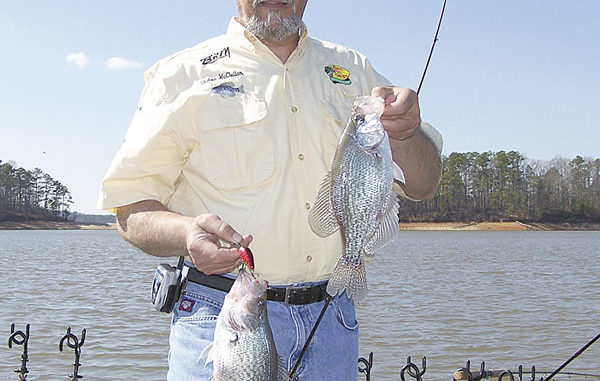
Shooting docks leads to great post-spawn fishing on Lake Hickory.
The spawn is over and done, and the crowds of perch-jerkers have gone home, so it must be time to get back to crappie fishing at Lake Hickory.
Every year, when the dogwoods bloom and fat crappie hit the banks, boat ramps are filled with “expert” fishermen who long for “crappie season” to load up on stringers of spawning slabs. With April in the rear-view mirror and crappie finished with their annual ritual, the season is over and done.
Now, if you’re a die-hard, the onset of May means the boat ramp is going to be a little less crowded, and there’s nothing better than pulling into the Wittenberg access area and not having to wait in line to launch.
That’s th way Randy Pope thinks. A native of Hickory, he relishes the time he can do a little target practice on his home lake. Pope is not a hunter. He doesn’t shoot deer or turkey; he shoots docks. Over the years, he and his former partner Jerry Pruitt have won seven major championship crappie tournaments. He fishes all over the country, and at each and every contest; his first and best choice is to shoot docks.
“Ninety-five percent of the tournament anglers I fish against troll for crappie using multiple-rod tactics” said Pope. “That style of fishing works great, but it’s not for me. I just don’t enjoy fishing that way — it’s boring; for me, if it ain’t fun, I don’t want to do it.”
He’d rather shoot.
For those unfamiliar with the tactic, shooting docks is a single-pole tactic for skipping a crappie jig into the furthest recesses under a boat dock, a piece of structure that crappie frequently use as a place to hide, ambush prey, or just hang out.
To shoot, you grip the tiny jig in one hand and bend the rod over into a bow. You open the bail on your spinning reel, holding the light line tight to the rod with your trigger finger. When you release the jig, the rod snaps forward, shooting the jig away from the rod tip. With critical timing, the trigger finger releases the line, allowing the jig to fly off on a flat trajectory.
Pope is a master dock-shooter. He can consistently hit an opening in a dock or gap between the motor and float of a pontoon boat that measures no more than six inches high and a foot across, skipping the light jig 15 to 20 feet back into the opening.
“The key is timing the release of the line and the jig,” he said. “Using 4-pound test allows me to get more distance, because the line comes off the reel easier. I’ve also put a lot of time in on the water shooting docks.”
Pope said most fishermen who try shooting docks are not successful because they don’t allow themselves enough time to learn how, where and when to use the tactic. For him, dock-shooting is nearly a year-round venture. He admits however, that it’s most effective during the late spring and fall.
Pope believes docks can hold crappie year-round on Lake Hickory and other reservoirs, and that a certain number of fish simply live under docks all the time. However, as water temperatures start to climb in May and spawn-weary crappie recuperate by replenishing their body weights, they become more aggressive. He explains that one of the best places to find recuperating, postspawn crappie are docks. The better ones have brushpiles under and around them and are a dominant form of cover.
“This time of year, I start the month keying on docks closer to the backs of creeks, and later in the month, (I) work out toward certain areas on the main lake,” Pope said. “I want a dock with a minimum of 10 feet under it early in the month. May is definitely a transition month, so the later in the month it gets, deeper docks closer to the main lake will hold more fish.
“Crappie will often hold out in front of those docks or around the sides if brush is present. Fish will trade between the docks and brush as the day wears on. They may be in the brush early and late and move up under the docks as the sun gets up.”
Experience has taught Pope which docks are likely to hold crappie at Hickory. Some locations are not hard to spot. Others require a little investigation.
“Brush can make a good dock better, but some docks are good just based on their location alone,” said Pope. “Hickory doesn’t have a lot of residents who fish off their docks, so you won’t see a lot of rod holders, lights and other signs of fishing activity on many docks. My favorite is an isolated dock that provides a lot of shade, is near deep water, and may have some natural cover like old stumps or a drop off under it. One of the newer forms of cover are boat lifts, when they are down in the water they can provide a lot of structure and hold fish.”
For fishermen who are interested in filling their freezers but don’t care to duel one-on-one with Hickory crappie, there is a machine-gun approach. Crappie pro Stokes McClellan of Huntersville counts himself among the other group that is more comfortable using an armload of rods when plying Hickory.
“Hickory is a great lake to long-line troll during the postspawn,” said McClellan, a member of the BnM Poles pro staff as well as the local Bass Pro Shops crappie guru. “Hickory will hold a number of solid crappie in the pound to pound-and-a-quarter class. It’s not really a big-fish lake, although we did real well out here last spring in a tournament with a big stringer of fish. It’s also not really known for numbers. An average day here will get you 30 to 40 keeper fish somewhere between 10 and 12 inches. It’s really a consistent crappie lake.”
McClellan trolls from a 17-foot Ranger 681 boat he has outfitted with an array of Driftmaster trolling bars and rod holders that allow him to space his rods across the transom. He uses rods between nine and 16 feet long, spacing from short to long the closer the rod holders are to the gunwales. The result is a barrage of 12 rods with different baits as he uses his Minn Kota 55 Auto Pilot trolling motor to steer and propel his boat along his trolling run.
Before he decides on an area to troll, McClellan will make several passes over open water looking for signs of baitfish and crappie on his Lowrance depthfinder. Like Pope, he understands that postspawn conditions will move baitfish back toward the main lake, so that’s one of the first places he’ll look.
“Primarily, I’m looking for bait close to the mouth of a creek,” he said. “I’ll make a note if I also see crappie while searching for bait, and the way the bait is behaving is key to catching fish. Scattered bait means something has made them nervous. If the big rolling schools are broken up, it’s usually because crappie are in there feeding on them. When I see this, I note what depth the bigger arches are at, so I know how deep to set up the trolling run.”
The amount of line out is a major factor in depth placement. McClellan uses Bass Pro Excel in 4-pound test and puts his baits 80 to 100 feet behind the boat. Another factor is boat speed; his typical speed range is just over one mph at 1.1 or 1.2 mph.
“I never go any slower than .7 mph,” he said. “I’ve found that the curlytail grubs I use won’t have enough action that slow, and the bait is dragged unnaturally through the water.”
McClellan said a 1/32nd-ounce jig 100 feet out on 4-pound test at one mph will swim at about 10 feet deep. Experience and practice are needed, and his first adjustment will be with boat speed, then jig weight, and then line distance out.
Although Pope and McClellan fish Hickory using completely different tactics, they may often be fishing within sight of each other.
“Gunpowder Creek is a long, winding creek with a pretty good open flat at the back,” McClellan said. “There are a lot of docks near the back, but I like to troll the open water between the docks. I usually start at the mouth of the creek and pull my way toward the back.”
“The Bethlehem area is also a great place to catch fish in May,” Pope said. “I’d rather fish water with a little stain, so that means I’m going to stay to the west of the dam and the big-water area. That includes everything from Cloninger’s Mill Pond back to Gunpowder Creek.”
“Along with Gunpowder and Bethlehem, I really like to troll near the Rink Dam which is back up in Little River,” McClellan said. “It’s full of brush and has a variety of water depths-anywhere from six feet up on the flat to over 30 feet at the creek channel.”
If they don’t happen to cross paths on the lake, Pope and McClellan may see each other at the ramp. Both point to the public Wittenburg ramp on the Alexander County side of the lake just west of the NC 127 bridge as the most convenient for reaching their favorite Lake Hickory hot spots.

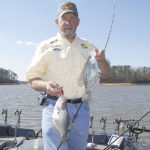
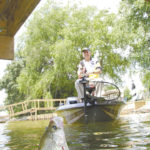
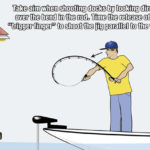
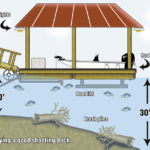
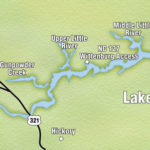
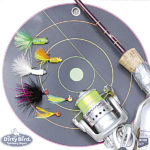
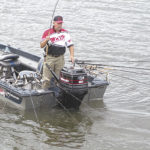



Be the first to comment